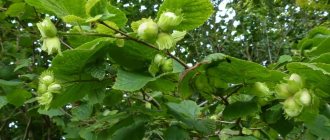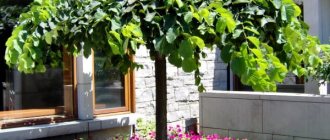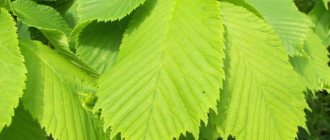Botanical description
Botanical illustration from Dietrich Brandis's book Illustrations of the Forest Flora of North-West and Central India
(English), 1874
Tree 10-12 m high, trunk 50-60 cm in diameter. The crown consists of long, thin branches hanging to the ground - bare, shiny, reddish or yellowish-green.
The leaves are oblong or narrowly lanceolate in shape, with a point elongated towards the apex, gradually narrowing towards the base; length 9-16 cm, width 1-2.5 cm. The edges are glandular-serrate, dark green above, bluish-green below. Young leaves are slightly pubescent, mature leaves are glabrous. The veins of the second order are thin, 15-30 pieces, extending to an angle of 45-70°. Stipules are obliquely lanceolate, jagged or awl-shaped; sometimes they turn into thorns. The petiole reaches a length of 1 cm, is hairy, and quite often glandular.
There are two stamens, they are free. There are two nectaries in male flowers, and one in female flowers[5].
The earrings are thin, appear either earlier or later than the leaves, located on short branches, thin-cylindrical. The calyxes are ovoid-lanceolate, the color is yellowish-green or pale fawn, always uniform. The stigma is thickened, yellowish in color, with 2-4 wide lobes[6].
Which variety should you choose?
The variety of willow species is great; most representatives of this genus look like low trees or shrubs, and some species grow up to 15-20 m . There are also super-tall willows that can grow up to 40 m, and their trunk diameter is at least half a meter. Hybrid interspecific variants are also often found.
In Russia, especially in its European part, willow is ubiquitous ; people call it broom, willow, willow, willow, willow or shelyuga. Shrub species can most often be found in Siberia and the Urals, and willow is also common in Central Asia. The wide range is explained by the fact that the plant is unpretentious to soil composition; it grows well on loamy substrates and light soil mixtures rich in organic matter. For willow, the proximity of groundwater does not matter; it tolerates such proximity well.
Traditionally, willows are planted in parks and squares near water bodies; this plant is used to strengthen coastal slopes and to create an attractive landscape design. The silver and weeping willows look especially impressive, descending their thin and flexible branches to the very edge of the water. An example of this type is a species called goat willow. In this case, the “Tent” variety will look no less attractive.
Such plants will decorate not only the edge of reservoirs, but also any open area of the garden , and the spreading crowns of openwork branches will provide excellent protection from the summer sun.
If you plant willows in 2 rows, you will get a kind of shady alley . For such plantings, you can use Ural sinuous or Matsuda willow. When arranging an alley, flexible branches of plants can be intertwined with each other, forming living arches from them - this design looks unusual and attractive, however, shoots can only be braided from plants that are already 3-4 years old, because the arches should be at a distance of 3-3, 5 m from ground level. If there is not enough space in the garden to form an alley or arch, it can be made from two small willow trees, connecting their crowns to each other.
To grow the shoots together and give them an impetus to grow, the ablation method is used , when special vaccinations are made on the branches. To decorate rocky gardens of rockeries, alpine hills or ordinary flower beds, low-growing shrubs or low standard trees are used. For this purpose, you can use willow varieties such as Swiss, Babylonian, Fantasy, and Golden Sunshine.
In order for a bush or small compact tree to look aesthetically pleasing, its crown requires regular care , which consists of pruning to create a certain shape.
Often, plants of the willow genus are planted at short intervals from each other in order to create a hedge . The tortuous, purple, and Caspian varieties are well suited for these purposes. Abundant shoots of these shrubs can decorate free space and protect other plants from the scorching sun. Willow bushes look original if they are planted sequentially along the garden path. A bold design decision would be to place decorative sculptures or small fountains near plantings. If you want to decorate a spacious lawn, then in its center you can plant a spreading brittle willow, whose crown will look like a dome. At the foot of this tree, which will eventually become tall, you can place flower plantings in a color scheme that harmonizes with the color of the willow foliage.
An interesting combination is the composition of willow and coniferous plants , whose dark green needles contrast effectively with delicate elongated silver leaves.
Classification
View Willow of Babylon
is included in the genus Willow (
Salix
) of the Willow family (
Salicaceae
).
| class Monocots | 36 more families (according to the APG II System) | about 250 more species | ||||||||||||||||||
| department Flowering plants | order Malpighiaceae | genus Willow | ||||||||||||||||||
| Kingdom of Plants | class Dicotyledons | Willow family | view Willow of Babylon | |||||||||||||||||
| about 21 more departments | another 36 dicotyledonous orders (according to the APG II System) | 56 more births | ||||||||||||||||||
Application of Willow
Willow is of great importance for agriculture and plays a large role in replenishing natural resources.
Willow is used as a protective planting, creating its own microclimate for planting and a protective area from the winds.
In depleted and depleted soil zones, Willow often becomes a “pioneer” and improves soil conditions for other plants. Fallen leaves of Willow improve the composition of substances. It is for these reasons that growing Willow is one of the techniques for improving forestry.
As a fast-growing tree, Willow is an excellent source of material. Some species are capable of producing an annual harvest.
Willow twigs are used in the manufacture of wicker furniture, baskets and other household items. The ease of replenishing these resources saves the forces of nature and makes it possible to preserve valuable forest plantations.
Woodworkers use willow bark when staining wood to imitate more expensive and valuable wood.
Notes
- For the convention of indicating the class of dicotyledons as a superior taxon for the group of plants described in this article, see the section “APG Systems” of the article “Dicotyledons”.
- ↑ 1 2
Russian name of the taxon - according to the following edition:
Shreter A.I., Panasyuk V.A.
Dictionary of plant names = Dictionary of Plant Names / Int. union biol. Sciences, National Faculty of Biologists of Russia, Vseros. Institute of Lec. and aromatic plants Ros. agricultural academies; Ed. prof. V. A. Bykova. - Königstein/Taunus (Germany): Keltz Scientific Books, 1999. - P. 669. - 1033 p. — ISBN 3-87429-398-X. - ↑ 1234
Rabotnov, 1951, p. 12. - Sergei Antonovich Shostakovsky. Systematics of higher plants. 1971, p. 131
- Sokolov S. Ya.
Genus 2. Willow - Salix L. // Trees and shrubs of the USSR. Wild, cultivated and promising for introduction. / Ed. volumes S. Ya. Sokolov. - M.-L.: Publishing House of the USSR Academy of Sciences, 1951. - T. II. Angiosperms. - P. 167. - 612 p. — 2500 copies. - Komarov V. L.
Genus 356 Willow - Salix L. // Flora of the USSR: in 30 volumes / ch. ed. V. L. Komarov. - M.; L.: Publishing House of the USSR Academy of Sciences, 1936. - T. 5 / ed. volumes V. L. Komarov. — P. 196-197. - 762, XXVI p. — 5175 copies. - Willow of Babylon
(English): information on the GRIN website. (Date accessed: October 10, 2010) - Pavlov N.V.
Plant raw materials of Kazakhstan. - USSR Academy of Sciences, 1947. - Babylonian willow
: information on the website “Encyclopedia of Ornamental Garden Plants” (Access date: October 10, 2010)
Willow silviculture[ | ]
Of the numerous species and varieties of willows in forestry, the following deserve attention:
- white, willow, willow, broom ( Salix alba
L., with the variety
Salix alba
var.
vitellina
); - brittle, willow, blackthroat ( Salix fragilis
L., with the variety
Salix russeliana
Sm.); - basketweed, basketwort, kuzovitsa, belotal, verbolosis, vine, small-wine, talazhchanik ( Salix viminalis
L., with the variety
Salix molissima
); - almond leaf, willow, redvine, tala, willow grass ( Salix amygdalina
L.,
Salix triandra
L.); - yellowberry, vine, willowweed ( Salix purpurea
L.,
Salix helix
Koch, with varieties
Salix lambertiana
and
Salix uralensis
); - shelyuga, verboz (Khark.), red grass ( Salix acutifolia
Wild.,
Salix caspica
); - pucker ( Salix hyppofaefolia
,
Salix viminalis
×
Salix amygdalina
); - Roman ( Salix smithiana
,
Salix capraea
×
Salix viminalis
) - cross: Salix purpurea
×
Salix viminalis
.
Although willows grow on all soils, deep loam or sandy loam, loose and moderately moist, are more suitable for them. Salix viminalis is the most demanding on soil.
;
Salix purpurea
and
Salix alba
grow successfully on peat soil ; Stagnation of water in the soil has a detrimental effect on the growth of willows. When establishing “willow thickets” or “willow thickets”, the soil is cultivated in the fall to a depth of 30-80 cm, depending on its fertility and dryness, so that the top plant layer is turned down, which is achieved by manual cultivation of 1-3 shovels, or making furrows with two plows running one after the other, with a subsoiler. Planting is done in the spring by cuttings - parts of one-year-old twigs, 25-30 cm long, cut in the fall and preserved in the cellar until spring. Cuttings are placed in rows running from southeast to northwest, with a distance between them of 30-40 cm and in a row of 10-20 cm, which will be from 125,000 to 333,333 cuttings per hectare, while on loose soil they are stuck straight hand, and on a dense one - into a hole made with an iron rod, flush with the surface of the soil, without leaving the tip of the cutting outside. But when breeding some willows, for example, when laying “shelyuzhniks” on loose sand, the branches of the shelyugi are directly placed in the plow furrows, one after another, covering them with a layer of sand raised when making the adjacent furrow. In the same way, for topless farming, willows are planted with stakes - 2-3 arshins in length and 1-3 arshins in thickness, stuck into the soil 1/3 of the way.
In accordance with the distribution of willow trees in a given area, plantings are distinguished:
- continuous, or field, when the entire area is allocated for it, except for ditches and roads;
- ordinary, of very different types: a) alternating
- stripes 1-3 m wide, alternating with fields or vineyards;
b) ridge
- on bogs and peat bogs, when willows are grown on ridges formed between ditches with earth taken from the latter;
c) ditch
- in which rods bent in a ring stick their ends into the walls of the ditch, etc. - nesting, used for strengthening slopes, slopes, river banks, etc., consisting of planting several cuttings on an area of pricked soil, in a group, or laying them out along the walls of a pit, then covered with earth, or in the placement of two rods, bent in arcs and intersecting between themselves into a hole made by a stake, etc.
Caring for willow trees consists of manually loosening the soil between the rows, removing weeds, hilling the stumps with soil, and even fertilizing the soil with Peruvian guano, Strassfurt salts, or year-old compost. The following adverse effects on farming in willow forests include hail, late spring frosts, and livestock grazing.
Literature
| Wikisource has texts on the topic: “ Salix babylonica ” |
- Komarov V. L.
Genus 356 Willow - Salix L. // Flora of the USSR: in 30 volumes / ch. ed. V. L. Komarov. - M.; L.: Publishing House of the USSR Academy of Sciences, 1936. - T. 5 / ed. volumes V. L. Komarov. — P. 196-197. - 762, XXVI p. — 5175 copies. - Rabotnov T. A.
Salix babylonica - Babylonian willow // Forage plants of hayfields and pastures of the USSR: in 3 volumes / ed. I. V. Larina. - M.; L.: Selkhozgiz, 1951. - T. 2: Dicotyledons (Chloranthaceae - Legumes). - P. 12. - 948 p. — 10,000 copies. - Sokolov S. Ya.
Genus 2. Willow - Salix L. // Trees and shrubs of the USSR. Wild, cultivated and promising for introduction. / Ed. volumes S. Ya. Sokolov. - M.-L.: Publishing House of the USSR Academy of Sciences, 1951. - T. II. Angiosperms. - P. 167. - 612 p. — 2500 copies.
| Dictionaries and encyclopedias |
|
| Taxonomy |
|
The healing properties of Willow
A decoction of Willow bark relieves rheumatic pain and is also used to treat colds and reduce fever.
Willow bark is rich in tannins, therefore it is used in the manufacture of medicines with disinfectant and antipyretic properties. In addition, the bark has a diuretic and diaphoretic effect.
Salicin (translated from Latin as “willow”) is also obtained from the bark of this tree. Salicin is the basis of aspirin.
Preparations from willow bark also have hemostatic properties. For inflammatory processes of the skin and abscesses, an ointment made from crushed bark and a fat base is used.
For thrombophlebitis, take foot baths from Willow decoction.
Dandruff, itching and hair loss are troubles that can be dealt with by a decoction of Burdock and Willow bark.
However, you should not overuse Willow decoctions due to the large amount of tannins in its bark.
Druid horoscope
March 1 - March 10; September 3 – September 12
With its songful, melancholic beauty, Willow is very attractive and unique. Even if only appearance determines the basis of her charm (especially if Iva is a woman), you feel something mysterious in her. She is full of unclear thoughts, unconscious desires, which sometimes she herself cannot define.
Very sensitive, loves the warmth of the sun and being near water. Reacts to all smells and tastes. Like no one else, he can use momentary joys and not deny himself any of them.
You should not trust Willow’s outward meekness. Contrary to her, she is businesslike and decisive, she knows well what she wants. She never imposes anything on anyone, because she has a developed sense of respect and no desire to command.
In feelings she is more romantic than sentimental. Loves sensual pleasures, brings a poetic coloring to them. Willow does not like everyday, colorless feelings.
She has artistic abilities, intuition and a rich imagination. Sometimes she is a good psychologist, which, with a certain insight, allows her to guess other people's thoughts and desires.
Her life could have been completely calm if not for the excessive attraction to love suffering. However, her complaints should not be taken seriously: feelings that are not embellished with suffering are not valued by her.
Traits of those born under the sign of Willow: intuition, rich imagination.











